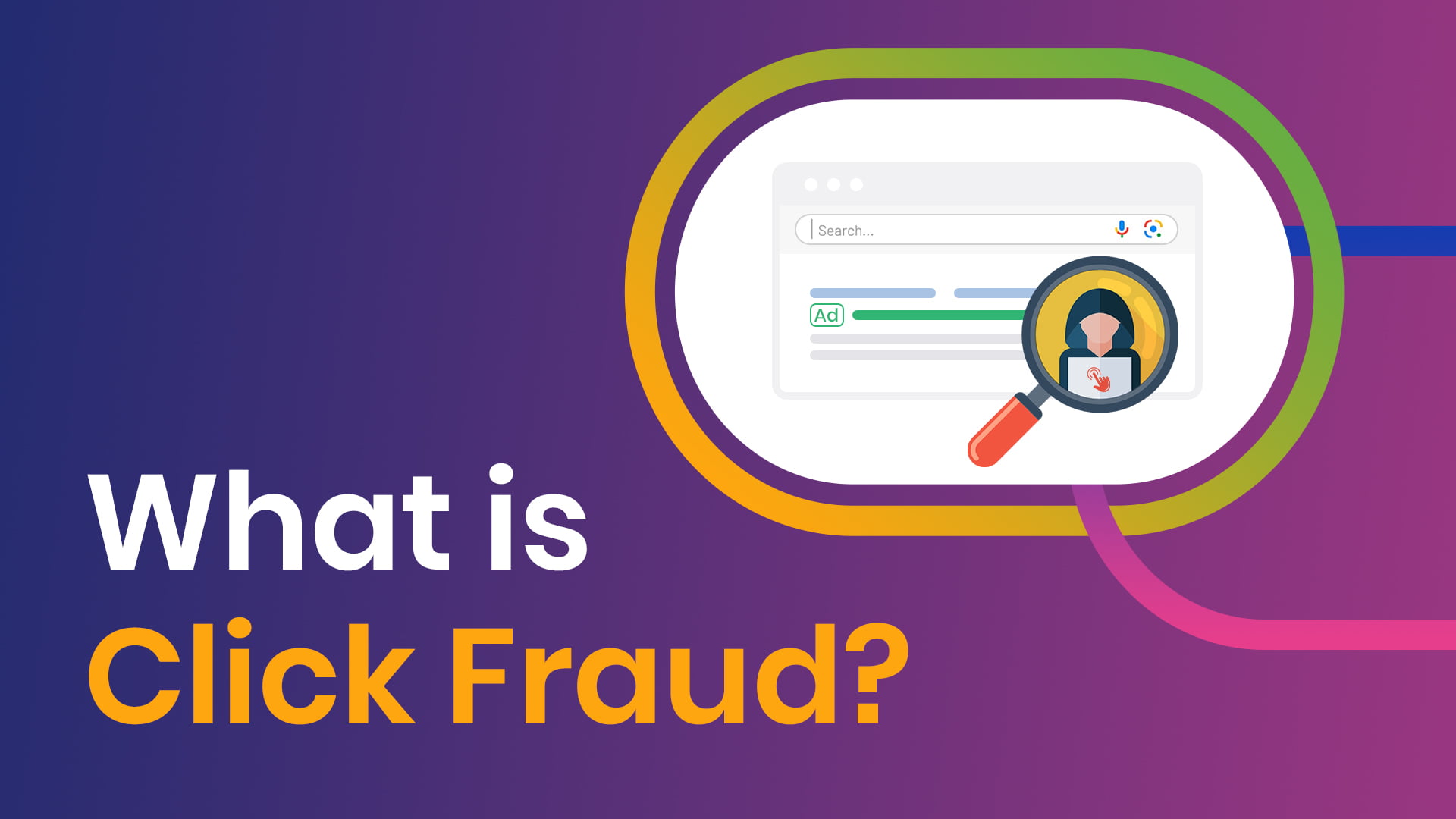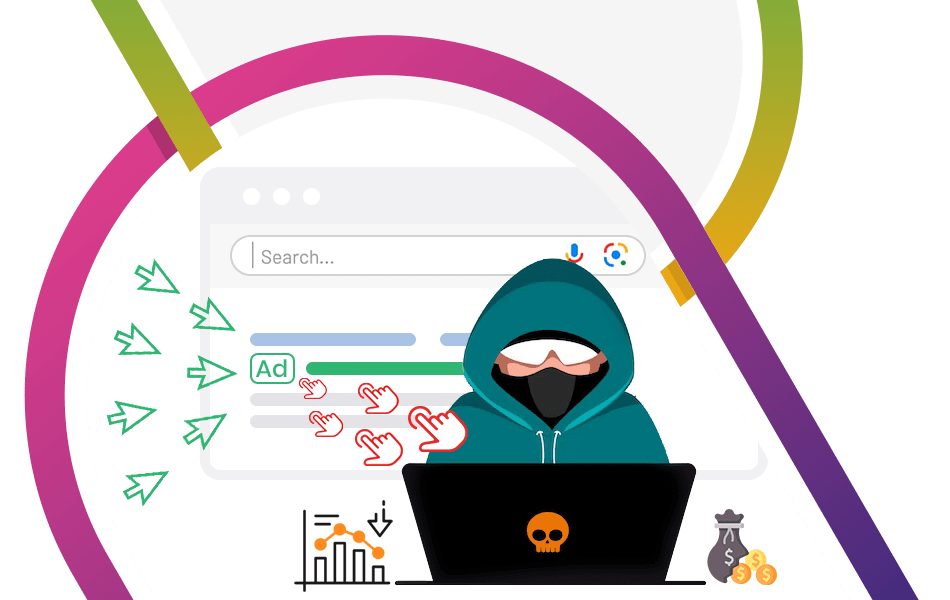
Free Digital Marketing Review
Elevate your online strategy with a personalised report and expert insights. Achieve your business goals faster!
What is Click Fraud, and why is it important?
Click fraud is a fraudulent technique used to artificially inflate the number of clicks on pay-per-click (PPC) advertisements. Advertisers pay a fee in PPC advertising each time their ad is clicked. Click fraud occurs when individuals, automated scripts, or botnets repeatedly click on these ads without genuine interest in the advertised product or service.
There are various motivations behind click fraud. It could be done by competitors to drain their rivals’ advertising budgets, by website owners to increase their revenue from ad networks, or by malicious actors seeking to disrupt advertising campaigns.
Click fraud can have significant consequences for advertisers, as it can waste their advertising budget without generating legitimate leads or sales. Ad networks and search engines employ techniques to detect and prevent click fraud, such as analysing click patterns, monitoring IP addresses, and using machine learning algorithms to identify suspicious behaviour.

How much does Click Fraud Cost – The Statistics
Overall Impact: Estimates suggest 14-38% of web traffic is automated, with 24% being malicious “bad bots” used for click fraud and other scams. (Source: Imperva)
Click Rate Studies show that:
11-36% of display ad clicks are fraudulent, depending on the platform and industry. (Sources: Lunio, Cheq)
14% of all paid search clicks originate from non-genuine sources. (Source: Cheq)
Financial Impact:
In 2023, fraudulent clicks on affiliate programs cost companies an estimated $3.4 billion. (Source: TrafficGuard)
Overall, ad fraud, which includes click fraud, will cost advertisers $61 billion in 2022. (Source: Cheq)
What is Click Fraud? Types of Click Fraud
Click Farms
In the context of click fraud, click farms are physical or virtual facilities where large groups of low-paid workers or automated programs are used to simulate genuine user clicks on advertisements, websites, or online content. This artificially inflates website traffic, engagement metrics, and ad clicks, benefiting the owner of the click farm and harming the advertiser or website owner in several ways:
Why Fraudsters Create Click Farms
Generating revenue: Click farms make money by charging advertisers or website owners for their inflated traffic or clicks.
Low costs: They typically operate in regions with low wages and use readily available tools or software, making them a cost-effective solution for fraudsters.
Harms Caused by Click Farms
Wasted advertising budget: Advertisers pay for clicks that generate no value, reducing their return on investment (ROI).
Skewed website data: Inflated traffic and engagement metrics distort website analytics, making it difficult to understand user behaviour and optimise content or marketing strategies.
Reduced user trust: Users might encounter spammy or irrelevant content due to click farms, leading to frustration and reduced trust on the website or brand.
Reputational damage: Associations with click fraud can negatively impact a website’s or brand’s image and credibility.
Types of Click Farms
Human-based: Workers perform simple tasks like clicking on ads or visiting websites for extended periods.
Bot-based: Software programs simulate user clicks and interactions on a large scale.
Mixed: Combine both human and bot activity.
Combating Click Farms
Ad platforms and website owners: Implement robust click fraud detection and prevention technologies.
Advertisers: Use ad networks with strong verification processes and choose placements carefully.
Law enforcement: Crack down on illegal click farm operations. Remember: Click farms are just one form of click fraud. Staying informed about different click fraud methods and utilising preventative measures are crucial to protecting your online presence and advertising budget.
What is Pixel Stuffing?
Pixel stuffing occurs when a seemingly normal ad contains a tiny, invisible pixel (usually 1×1 pixel) packed with additional, hidden ads. These hidden ads are undetectable to users but still register impressions, resulting in:
Inflated Cost: Advertisers pay for impressions (even when users can’t see them), wasting their budget.
Skewed Metrics: Click-through rates (CTRs) and other metrics become inaccurate, hindering campaign optimisation.
Reduced Engagement: Real users see only one ad, while others generate revenue for fraudsters.
How Does it Work?
Fraudsters typically achieve pixel stuffing through iframe embedding:
They create a normal-looking ad containing an invisible pixel.
Inside the pixel, they use an iframe to load multiple additional ads.
These ads remain hidden by the pixel’s size and positioning.
As users see the main ad, impressions are counted for visible and hidden ads, generating fraudulent revenue.
How to Prevent it?
While eliminating pixel stuffing is challenging, advertisers can take steps to minimise its impact:
Work with reputable ad networks: Choose advertising platforms with robust fraud detection measures.
Monitor campaigns closely: Track impressions, clicks, and conversions to identify unusual spikes or patterns.
Utilise click fraud prevention tools: Invest in advanced detection and filtering solutions.
Avoid high-risk placements: Avoid advertising on websites or apps with known click fraud issues.
Focus on legitimate conversions: Prioritize actual conversions like website visits or purchases, not just clicks.
By understanding pixel stuffing and implementing preventive measures, you can protect your advertising campaigns from this fraud and optimise your budget for genuine user engagement.
What is cookie stuffing?
In the world of affiliate marketing, cookie stuffing is a deceptive practice where a third-party attempts to surreptitiously place multiple tracking cookies on a user’s device without their knowledge or consent. These cookies are typically associated with affiliate programs, where website owners earn commissions based on user clicks or purchases referred through their site.
Here’s how cookie stuffing works
You visit a website. This website is unrelated to any affiliate program.
Third-party scripts or hidden elements on the site (e.g., pop-ups, browser extensions) place cookies associated with various affiliate programs on your device without your awareness.
Later, if you purchase on a different website, even if you reached it directly or through another legitimate source, some of the stuffed cookies might claim credit for the referral.
The affiliate program then mistakenly rewards the cookie stuffer with a commission as if they had referred you, stealing credit from other legitimate affiliates or the merchant itself.
Cookie stuffing is problematic for several reasons:
Unfairness: It unfairly takes away commissions from legitimate affiliates who genuinely refer users.
Deception: Users are unaware of cookies being placed, violating their privacy and trust.
Distorted data: Inflated affiliate traffic and conversions make it difficult to track campaign performance accurately.
Reputational damage: Merchants and programs associated with stuffing risk losing trust and facing legal repercussions.
While cookie stuffing is considered unethical and often penalized by affiliate networks, it remains a persistent issue.
Here are some ways to protect yourself:
Be cautious about unknown websites: Avoid clicking on suspicious links or visiting sites with questionable practices.
Use anti-tracking tools: Consider browser extensions or privacy software that block unwanted cookies and scripts.
Clear your cookies regularly: This helps remove potentially harmful cookies.
Be mindful of permissions: Don’t grant unnecessary permissions to websites or extensions.
Report suspicious activity: If you suspect cookie stuffing, report it to the website owner and relevant affiliate network.
By staying informed and taking preventative measures, you can minimise the impact of cookie stuffing and protect your data and online experience.
What is Click Fraud, and Why is Performance Max So Susceptible?
Click fraud and Performance Max (PMax) campaigns are a concerning combination. While PMax offers several advantages, its automated nature and broad reach can make it vulnerable to certain types of click fraud. Here’s a breakdown of their connection:
How is PMax susceptible?
Large Audience Targeting: PMax campaigns target audiences across various Google platforms, including Display Network, Search Partners, YouTube, Gmail, and Discover. This vast reach increases the chance of encountering fraudulent websites and apps where bots or humans might click your ads without genuine interest.
Limited Granularity: PMax offers less control compared to traditional campaigns. While you can exclude negative placements and keywords, the automated optimisation might still deliver your ads on platforms with higher fraud rates.
Conversion-Based Bidding: PMax focuses on achieving conversions rather than clicks. This makes it attractive to fraudsters who can simulate conversion actions without genuine interest, wasting your budget. Impact of click fraud on PMax campaigns
Wasted Budget: Clicks from bots or fake users drain your budget without generating valuable leads or sales.
Skewed Data: Fraudulent clicks distort campaign performance metrics, making it difficult to understand what’s working and optimise effectively.
Reputational Damage: Clicking on your ad on a malicious website can associate your brand with negative connotations.
How to Protect your PMax campaigns from Click Fraud
Monitor Performance: Regularly analyse clicks, conversions, and other key metrics to identify suspicious activity. Look for sudden spikes in clicks with low conversion rates or clicks from unusual locations.
Consider Third-Party Solutions: Invest in specialised click fraud prevention tools that offer deeper insights and advanced filtering capabilities.
Optimise Targeting: While PMax offers less control, refine your targeting parameters whenever possible. Exclude sensitive categories, specific placements, and low-performing demographics.
Track Conversions Closely: Focus on real conversions like website visits, purchases, or form submissions, not just clicks. This helps PMax learn and prioritise genuine interactions.
Click fraud is a complex issue; a multi-layered approach is essential to protect your PMax campaigns. You can minimise its impact and maximise your advertising ROI by staying vigilant and employing available click fraud tools.
Click Fraud Trends
Cost is Rising: While click fraud rates might fluctuate, the growing digital ad spending means the financial impact is increasing.
Fraudsters Evolve: Methods constantly innovate, making detection and prevention more challenging.
Click Farms: Large-scale operations generating numerous fraudulent clicks significantly inflate costs.
Click Fraud In 2023
The Association of National Advertisers (ANA) estimated global ad fraud costs $120 billion. This broader category includes click fraud and fraudulent activities like fake impressions and bot traffic.
CHEQ estimated the total cost of ad fraud specifically at $61 billion. This figure considers all types of ad fraud, but click fraud likely makes up a significant portion.
Click Fraud In 2022
The Interactive Advertising Bureau (IAB) estimated global ad fraud cost at $42 billion.
Click Fraud in 2021
CHEQ found click fraud rates remained constant at 14.08%, but with increased ad spending, the financial impact grew to $35 billion.
Click Fraud In 2020
Global ad fraud was estimated at $35 billion by Statista.
Sophistication: Fraudsters constantly evolve their methods, making detection and prevention more complex.
Focus on Click Farms: While individual clicks might be cheap, click farms generating large clicks can inflate costs significantly. While specific year-on-year trends for click fraud alone are hard to pinpoint, the data clearly shows it’s a significant and growing problem. Businesses should know the risks and invest in click fraud prevention solutions to protect their advertising budgets.
What next for Click Fraud?
Click fraud is unlikely to go away. It’s a valuable opportunity to make money, and with technology and automation come additional opportunities. Invest in a click fraud tool.
Due to our click fraud tools, our clients save, on average, between 10% and 30% of their monthly budget. Would you like to?

Need help with your website and marketing?
Book a FREE growth strategy session with our experts
Our award-winning team will review your website and marketing goals to provide you with crucial insight and advice.

4.9 STAR
Google reviews
With 10+ years of experience, Link Digital has helped hundreds of businesses to succeed online. We can help yours too!

